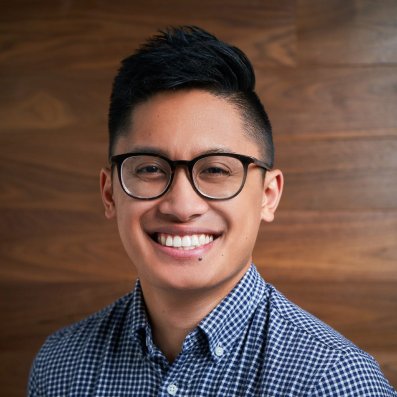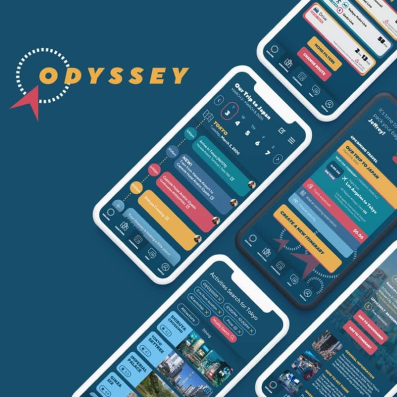
Jeffrey Surban was living the picture-perfect dream. He’d moved to Los Angeles to get a bachelor’s degree in film from Marymount Loyola University, where he made the Dean’s List. Fresh out of college, he landed a job at NBCUniversal working in post-production for television. As a visual designer, he produced commercials, graphics, and other branded content for household names including Google, Disney, Microsoft, and Toyota.
A few years in, Jeff realized he was more interested in understanding the end-user experience, instead of being on what often felt like an assembly line for TV programming: insert visual effects here, color corrections there, check the sound effects, go live.
After completing Springboard’s UX Design Career Track in March, Jeff started a new job as a UX designer for Citigroup. Job searching during the COVID-19 pandemic was no easy feat, so after going the traditional route of applying to job boards with little to show for it, Jeff decided to direct-message a creative director on LinkedIn. The move paid off; he landed an interview with Citi—and the rest is history.

I was working in television post-production at NBCUniversal doing visual design and also post-production, which is video editing, visual effects, color correction, and audio mixing. I don’t think post-production was really the end-game for me.
I really wanted to take it to the next level and work on things that people use every day. TV is very machine-driven. We’re on air 24/7 and we’re just making graphics and commercials all the time without any purpose behind it. With UX design, you have research and the user behind it, which adds this whole level of fulfillment to what you do.
I compared the Springboard UX Career Track to so many others and one of the things that really stood out was the industry-design project and getting real-world experience in UX design.
I worked with a startup called Spatial First, where I revamped and refined the user flow and interactions for their PlaceTime app, including onboarding, property listings, and property overviews to decrease the rate of abandonment by 80% percent and increase the leasing rate by 50%.
One of the big UX projects we did at NBC was our project with Google. Basically, we did a commercial shoot for them but they didn’t have any of the screens ready for their Google Home product hub, so they asked us to make screens for them. I partnered up with their consumer marketing team and their product team and we developed all these interactions, animations, and UI elements, and I was working with Sketch and Adobe After Effects for the first time. It really blew my mind.
It was that big ‘aha!’ moment and I thought, I need to do this in the next step of my career.
Leaving the Hollywood dream behind was kind of humbling, but I think it will be worth it.
My Springboard mentor really challenged me and made me a better designer. I would come to her and ask her to spoon-feed me the answers because I didn’t know what I was doing, and she would be like, “Okay, no, no, no, this is not my job. My job is to let you make your own design decisions, let you fail, make you take risks, and then you can learn from it.”
I really appreciated her approach, because if she just told me, “change this, move that” I wouldn’t have learned anything.
"My Springboard mentor really challenged me and made me a better designer."
The idea was to make an all-in-one travel planning tool to help people plan the ultimate itinerary. I know travel is so irrelevant these days and it feels like a distant past, but I really wanted to create something like this because traveling is definitely one of my hobbies.
We went all the way to prototyping and doing two rounds of usability testing and iterating based on user feedback. One of the biggest discoveries I had was people said the app was more like an inspiration app than a planning app, so I had to go back and change the user flow to make it seem like this was meant for vacation planning.

I just started applying locally in LA because I’ve been here for over a decade and didn’t want to lose my friends and my network. I think I should have cast a wider net because I missed out on other opportunities. It was definitely a lot more rejection than anything.
What really kept me going was definitely meeting with a career coach every week. I don’t want to label them as therapists because that’s a lot of emotional baggage to carry for sure, but they definitely talked me through and helped me re-strategize and re-evaluate my plan when I needed to, and that helped me a lot.
I cannot thank the people in career services enough—they really guided me through the process and they were with me every step of the way. When things were happening so fast with my new job at CitiGroup, they helped me negotiate. They went through my entire cover letter. All these things made me feel like Springboard cared; they didn’t just abandon me and say, “Oh, you got an offer letter, okay, goodbye!” I didn’t feel like I was just a statistic.
I would say it’s definitely never too late. I think life is just about learning who you’re meant to be and what your purpose is, what you're passionate about, and you’ll never know until you try. I’m glad that I’ve taken the risk.
I went to the Springboard RISE Conference in September 2019, and one of the speakers said that sometimes it can feel like this career change is a step down—but it’s really not. It’s about downshifting so you can accelerate further in the future, and that’s where I feel like I am now.
Here at Springboard, not only do we pride ourselves on our students’ successes, but we genuinely believe that their dreams are what make up the foundation of our mission. Our alumni dream big—and they make big moves in stride. So we’re shining a light onto some of our favorite alumni stories: their journeys tell stories of accomplishment, grit, and determination against all kinds of odds.
Find more inspiring Springboard student success stories here.









